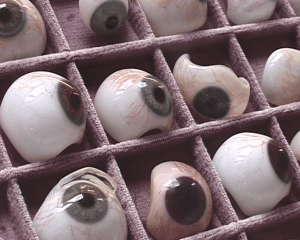Glass from Thuringia: Glass eyes - German/German

The artificial human eyes look strange and eerie. Alongside the bric-a-brac figures, however, they show in an impressive way that the Thuringian glassblowers were already outstripping the cultural metropolis of Paris in the 18th century in the medical-technical field.
In 1832, the medic Heinrich Adelmann from Würzburg became aware of the glass eyes that the Thuringians were making for dolls and stuffed animals at the time. He enthusiastically commissioned the Thuringian glassblower Ludwig Friedrich Müller-Uri to produce artificial human eyes for the German market. This was because Parisian glass eyes were considered luxury items, but lasted only five months and had a high lead content. Instead of lead, Müller-Uri used leg glass - bone ash from animals - to colour the eyes white. Instead of enamel colours for the iris, he made self-twisted glass rods, which he melted onto the glass base. The filigree grain of the iris and the lifelike colours made the glass eyes look deceptively real. However, the tear fluid still roughened the glass, so that it had to be replaced after some time. Müller-Uri and other eye artists only solved this problem in 1886 with the newly invented cryolite glass. It made the new Thuringian glass eyes durable and light.
Our glass eyes were donated by the Würzburg glass eye company Fritz Hellbach and the Wertheim glass eye artist Bruno Köhler.
Glass from Thuringia: Glass Eyes - English

These artificial human eyes are both curious and spooky. Alongside the porcelain figurines however, they demonstrate how impressively the Thuringian glassblowers outstripped others in Paris during the 18th century in the branch of medical technology.
In 1832 the glass eyes that were produced in Thuringia for dolls and soft toys, came to the attention of a Würzburg doctor called Heinrich Adelmann. Amazed by their quality he contracted the Thuringian glassblower Ludwig Friedrich Müller-Uri to produce artificial human eyes for the German market. Parisian glass eyes were a luxury article that only lasted five months and contained a lot of lead. Müller-Uri used milk glass, which was made from the ash of animal bones, to colour the eyes white, instead of lead-based glass. And instead of using enamel colours for the iris he used his own turned little glass rods that he smelted to the eye itself. The filigree texture of the iris and the natural colours made the eyes look deceptively real, but tear fluid still roughened up the glass, so that it had to be changed after a certain period of time. Müller-Uri didn't solve this problem until 1886 in collaboration with the other eye artists with the newly discovered cryolite glass. This made the new Thuringian glass eyes both enduring and light.
A Wertheim Glass eye artist named Bruno Köhler from the Würzburg Fritz Hellbach Glass Eye Company donated our glass eyes to us.